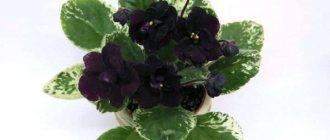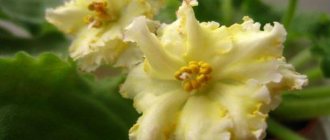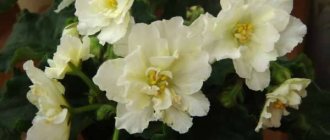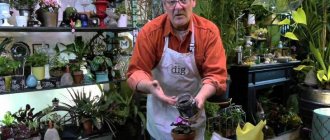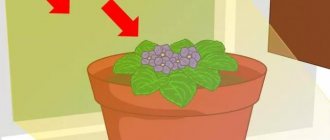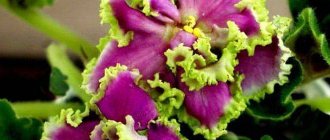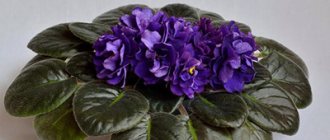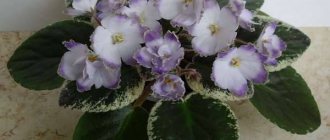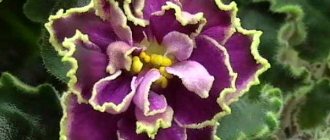Many amateur flower growers are not too seriously interested in a new variety in their collection; it is only important that they are satisfied with the external parameters and study the general rules of care.
When a more serious gardener approaches the selection of a new individual for his collection, he
studies in more detail all the nuances of interest .
Among them is an accurate description of the variety, for comparison and identification of possible sports. In addition, it is important to study the care features , which, depending on the variety, may differ slightly from those that are usually used for this species. In the article you will see a photo and description of the variety.
Violet AE-Armageddon (E. Arkhipov)
Mysterious violet Armageddon.
AE-Armageddon belongs to Uzambor violets , from the genus of hybrid Saintpaulias, class Gesneriev. E. Arkhipov was involved in breeding the variety, as evidenced by the prefix AE in the name.
The rosette belongs to large standards, and in good conditions grows to 50-55 cm in diameter . Sheets:
- Large;
- On cuttings;
- Reach 15 cm in length.
color :
- Uniform;
- Deep green.
Flowers are often lost against the background of such a rosette .
quite large in diameter (up to 5 cm), but gets lost on a large bush. A double or semi-double flower in the first days pleases with the brightness of its color, which quickly fades.
The main color of the petals is purple-black , with clear polka dots of light fantasy.
are quite common for this variety . In most cases, the flowers are solid, dark (primary) color, or light as peas.
Important! Sometimes the first flowering may not correspond to the varietal characteristics, but this does not make the individual a sport. Flowering may be affected by the characteristics of the content.
Caring for a plant at home
Content requirements
Like all Saintpaulias, AE-Armageddon prefers bright, diffused light . Grows well on a windowsill where there is no direct sunlight. With additional light, for example under a lamp, the rosette can reach 55 cm in diameter.
Like many violets, this variety loves diffused light.
It is recommended to maintain the temperature within 24° C, deviation plus or minus 2°. At the same time, AE-Armageddon reacts well to natural temperature conditions; it is only important to prevent the temperature from dropping :
- Below 16֯;
- And also increases - above 26֯.
Attention! Like all Saintpaulias, the variety tolerates increased temperatures better (subject to frequent watering) than hypothermia.
It is recommended to keep the air humidity in the room at a suitable level - about 60% . If the water level in the air near the violet is high, rotting of parts of the plant (roots, leaves, growing point) occurs.
If there is excessive dryness, especially in the heat, the leaves first wither , and then the growing point may simply burn out, but the plant can be saved by frequent watering.
Watering and fertilizing
The AE-Armageddon variety responds well to different types of watering :
- Classic - in a tray or under the leaves (avoiding contact with the leaves and growing point). The procedure is carried out as needed, when the earthen clod dries out, about once a week, at a temperature of 25°. For this type of irrigation, fertilizing is carried out through irrigation (about once every 2 weeks), and the dosage of mineral fertilizer is reduced by half, relative to that stated by the manufacturer;
- Wick – the water is in a container under the pot, and the plant draws it through the wick, lowered by the lower drainage hole. In this option, water is constantly in the container and fertilizer as well. The concentration of mineral fertilizer is reduced by 7-8 times relative to that declared by the manufacturer.
The variety must be watered as the soil dries.
Rejuvenation, transplant
The variety needs frequent replanting, both during growth and after. Typically, the procedure is carried out once a year (sometimes more often) - for an adult plant and, as necessary, for a growing rosette. Depending on the purpose of the transplant, it is carried out in two ways :
- Transshipment - for a growing individual, in order to enlarge the pot. To do this, prepare a new pot, a little larger than the old one, a substrate and the plant itself. Next, simply transfer the rosette, along with the old soil, into a new pot and sprinkle it in a circle with new soil;
- Replanting with soil replacement - during a planned replanting, or in case of illness. The tools are the same as for the first option. Saintpaulia is taken out from the flowerpot, all soil is shaken off, damaged roots are removed, and the lower leaves are cut off. During planting, the stem is buried, placed strictly in the center and covered with soil, avoiding contact with the leaves.
Often, the method of replanting with soil replacement is used for rejuvenation , in which several rows of leaves are cut and, if necessary, the stem is cut from below to the level of living roots.
faded leaves and peduncles are trimmed as necessary , otherwise they:
- They pull juice from the outlet;
- And they spoil the appearance.
Important! To prevent excessive growth of the rosette, it is often replanted, but fertilizers and artificial lighting are not used.
For planting and replanting Saintpaulias, it is important to use suitable soil, it can be :
- Buy in store;
- Or make it at home.
The substrate is made up of equal parts :
- Peat;
- Ground;
- And perlite;
- And also add one third of the sphagnum moss.
You can collect the soil yourself at home.
For wick irrigation, only peat and perlite are used in equal parts .
Reproduction
Like all Saintpaulias, propagation is carried out vegetatively (to obtain new varieties - by seeds):
- Leaf cuttings - use material from the second or third row. Rooting is carried out in water, soil or moss. After the babies appear and grow to 4-6 leaves, after which they are seated;
- Stepchildren - stepchildren are planted with their own roots, or if there are 4-6 leaves, they are rooted like a leaf cutting;
- Peduncles – they are rooted in the soil under the film.
Most often, violets are propagated by leaves.
Diseases and pests and methods of combating them
Dolce Vita violets are quite resistant to diseases, but there are a number of factors that affect the health of a houseplant. The main causes of disease can be heavy soil, cold air, too spacious a pot, drafts, direct exposure to the sun, cold water, lack of light, etc.
The most dangerous disease is considered to be late blight, which occurs due to fungal etiology. Obvious symptoms are brown spots on plant leaves. For prevention purposes, you should maintain optimal humidity in the room and fertilize the soil with superphosphate.
Attention. Treatment of late blight is ineffective, so diseased violets are destroyed. Since fungal spores live in the soil for a long time, the pot after the affected plant is thoroughly sterilized.
Dolce Vita violet may suffer from fusarium or late blight.
As a result of improper care, another disease can occur - fusarium. After the Fusarium fungus enters, the following picture is observed: the petioles of the leaves acquire a brown tint, the roots darken and begin to easily separate from the ground. As a therapeutic measure, spraying with fungicides is used, while rotten and dried parts of the plant are removed.
Gray rot appears as a white coating on flowers, leaves and petioles. The disease develops rapidly and can lead to the death of the violet. The main drugs for the treatment of gray rot are fungicides.
Widespread pests include:
- Scale insects deforming plant leaves. The bite sites turn into brownish spots. The most effective drugs in treatment are Aktara, Fitoverm and Actellik.
- Aphids attacking flowers and peduncles. These parasites feed on the juice of violets, which leads to poor growth, deformation and wilting of the petals. High-quality products in the fight against aphids are Actellik and Mospilan.
- Mites that threaten to dry out and deform the leaves. Small brown or white-yellow spots are visible to the naked eye on the leaf blades, the rosette becomes denser, and a grayish coating appears at the base of the leaves. Treatment is carried out using the drugs Akarin, Actellik and Fitoverm.
The leaves and flowers of Dolce Vita violet can be damaged by various pests.
Reviews
Marina. “I bought the baby AE-Armageddon. She grew so sharply that I was a little scared that something might be wrong. But then I looked for information and everything fell into place. I love big violets, so I let it grow. But after the first flowering I regretted it; it was worth limiting its growth. Flowers on such a huge scale look funny, they seem so small.”
Olesya. “I saw AE-Armageddon blooming and bought a leaf; when the rosette grew, I was looking forward to flowering. When the first buds appeared, there was disappointment, because they were lost against the background of large leaves.
I gave her a second chance, but even the second time the flowers seemed very small relative to the rosette.
So I just gave it to my friend. In favor of the variety, I would like to note the beautiful color of the flowers.”
Features of flowering, growth and reproduction
Children grow and develop well at home. With frequent replanting and natural light it blooms early ; if fertilizers are used, the first buds appear even earlier.
Attention! An adult bush can be obtained in 11-13 months.
There are not many buds on the peduncles (2-5), and the peduncles themselves are :
- Sturdy;
- And upright.
Cap flowering is not uncommon for this variety, but it is more of a bouquet than a cap. The buds last a long time, about two to three weeks . In the first days, up to a week, the color is bright and fancy, then the petals gradually lighten to the shade of peas.
Despite the fairly good size of the flowers, 5 cm in diameter, they seem small on a huge rosette.
Color is slightly affected by temperature , for example:
- In hot weather, fancy peas sometimes disappear;
- And in cool weather, some buds may lighten.
Reproduction is possible by all vegetative methods . It is important to consider that with leaf cuttings the number of sports increases.
Some tips from flower growers
With proper care, Dolce Vita violets will reward you with lush and amazingly beautiful flowering. On average, these plants bloom for about two months, and gardeners recommend promptly removing faded flowers.
In winter, violets require special care, especially with regard to lighting. Since daylight hours are shorter in winter, it is advisable to increase it using artificial lighting lamps.
These beauties do not tolerate waterlogging of the soil, excess humid air and spraying of foliage. The plant is cleaned of dust exclusively in the shower, but taken out in a dry state.
Violet growers also recommend not growing violets next to large plants such as ficus and palm trees. They can serve as sources of mites, aphids and thrips. It is useful to place geranium next to the violet, which repels pests, and spathiphyllum, which moisturizes the air well.

